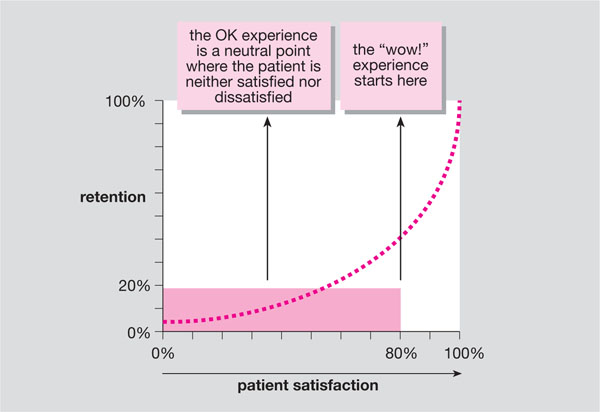Chapter 3
Patient-centred Care
The blend of art and science that is dentistry can make us forget that the business of dentistry is a “people business” and that we should adopt a patient-centred approach in all that we do. Patient-centred care is about relationship management. The relationship between dentist and patient should be one built on trust. “Technique and technology are important”, says Tom Peters, “but adding trust is the issue of the decade.”
In the July 2000 NHS Plan, a patient-centred service was amongst the leading pledges of the government. A briefing paper from the King’s Fund noted that:
“Patient-centred care demands that health professional do not simply diagnose and treat illness as a technical exercise in problem solving but that they work in partnership with patients and carers – listening to their concerns, responding to their anxieties, acknowledging their values and respecting multiple demands on their lives. It means that each consultation between a health professional and a patient is an exercise in partnership, with equal power rather than one dominating the other.”
The sentiment would apply equally when seen from a business perspective.
Relationship Management
Relationship management is all about communication and delivering and exceeding the patient’s expectations. We know that effective communication skills are amongst the most valued skills from a patient’s perspective and there have been studies undertaken to try to identify what elements of the interpersonal relationship most matter to patients. The identified factors were:
-
being greeted warmly
-
being listened to
-
receiving clear explanations
-
being given reassurance
-
having confidence in the health professional’s abilities
-
being able to express concerns and fears
-
being respected
-
being given enough time during the visit
-
consideration being made of their personal context
-
concern being given for the patient as a person
The 2 June 2002 Business Section of the The Sunday Times carried an article by Maria Yapp about high flyers in business. She quoted from the work of leading business psychologists and concluded that, in addition to core capabilities, “high flyers have emotional intelligence – superior ‘soft’ skills – which they use to form and manage relationships. They are skilled in negotiation and leadership, demonstrating enhanced ability in the way they motivate and deal with others”.
Dealing with people can be difficult, and dealing with difficult people is often impossible. The reason, according to Dale Carnegie, is that when dealing with people we must remember that we are not dealing with creatures of logic but with creatures of emotion.
Satisfaction and Loyalty
In the past there has been some assumptions in business that:
-
it is sufficient simply to satisfy your customer.
-
the time and energy involved to create absolute satisfaction are not worth it
-
efforts at delivering satisfaction should be based on lowest common denominators, i.e. “base-line expectations”.
These assumptions do not accurately reflect what is known about relationship management in business today. The relationship between customer satisfaction and loyalty (retention) is not a linear one. It reflects the skewed relationship that is Pareto’s principle (see Chapter 1). The level of satisfaction that produces an exponential rise in loyalty (increased loyalty) comes from the last 20% of the effort to deliver that satisfaction. This relationship is shown in Fig 3-1.

Fig 3-1 The relationship between patient satisfaction and retention.
The shaded area is the “zone of defection” where the patient could easily seek care elsewhere. This zone gets narrower as the relationship between dentist and patient matures and goodwill is added to the emotional bank account. Satisfaction because a cumulative experience.
The challenge of delivering the “wow!” experience is that it gets harder each time you interact with the patient. Today’s “wow!” factor is tomorrow’s baseline expectation. For example, I recall a patient who was telephoned after the uneventful extraction of a lower third molar. The patient was delighted to receive the call and could not thank me enough. Two weeks later, after the extraction of the opposite molar, I failed to call the patient during the evening as I was attending a lecture. On his return to the practice the following week for a review appointment, the patient thanked me again for calling him the first time, but remarked that he was disappointed not to receive a call from me on the second occasion. Apparently he had planned to go out but thought he would stay in as he expected me to telephone. I had delivered the “wow!” experience on the first occasion but fallen short of the expectation on the second. From “wow!” to a veiled complaint in less than ten working days!
Delivering Satisfaction
Many studies looking into patient satisfaction with dental care identify five generic themes. These are:
-
technical competence
-
interpersonal factors
-
convenience
-
costs
-
facilities.
The results have been contradictory because of demographic variables, such as:
Age Patients of 60 years of age or more tend to be more satisfied with their dental care than younger patients, but less satisfied with the communication process.
Gender Women express greater levels of satisfaction with dental care than men. One reason may be their greater exposure to the service, which in turn could have a moderating effect on their expectations.
Economic status Patients from low-income groups have different attitudes to their dental health and seek care less frequently.
Previous dental experiences Patients whose previous experience of their dentist has been positive report higher levels of satisfaction. They will forgive the occasional episode of poor performance, attributing this to “uncontrollable” or “sporadic” elements.
Regular v. irregular attendance Some studies have indicated no difference between the two groups but others have suggested that there is a positive correlation between frequency of attendance and satisfaction.
Anxiety levels It has been demonstrated that patients who exhibit high levels of anxiety tend to be more dissatisfied with their care than their l/>
Stay updated, free dental videos. Join our Telegram channel

VIDEdental - Online dental courses


